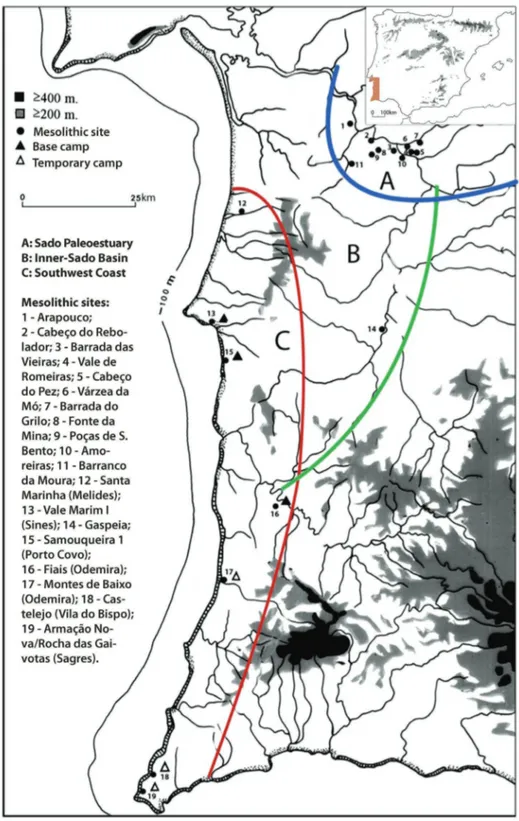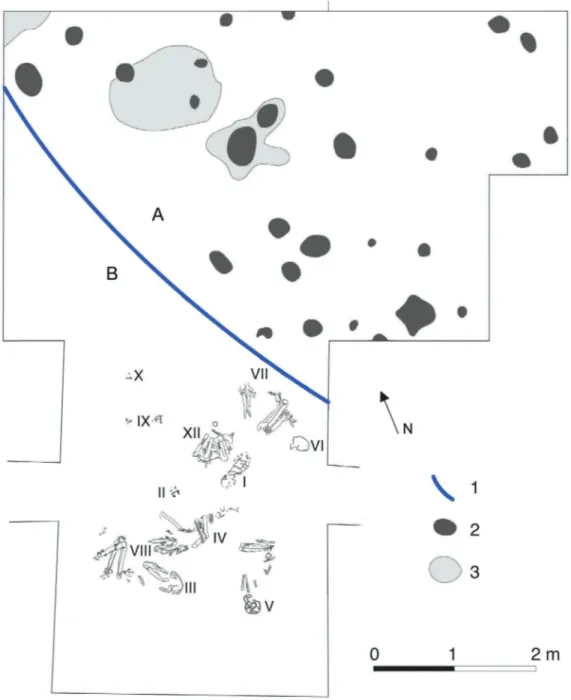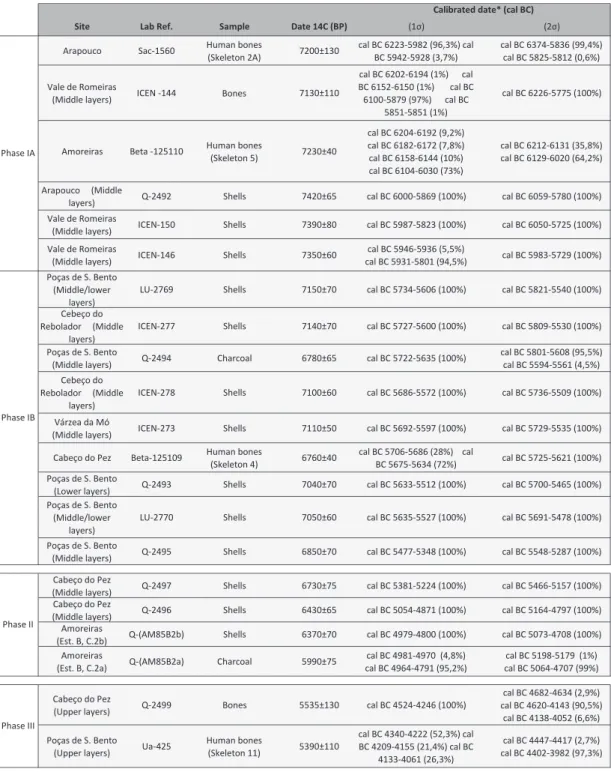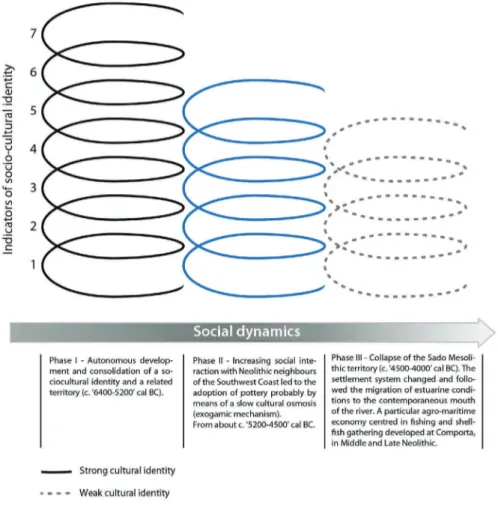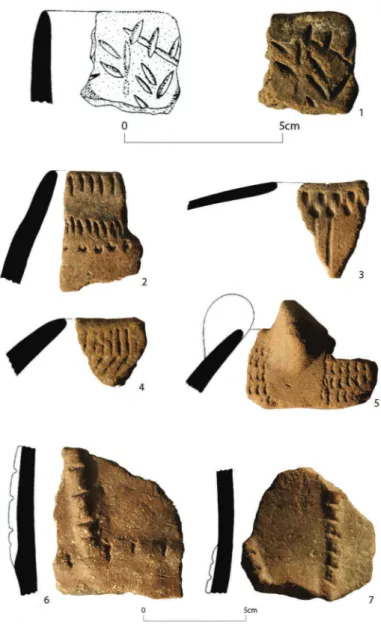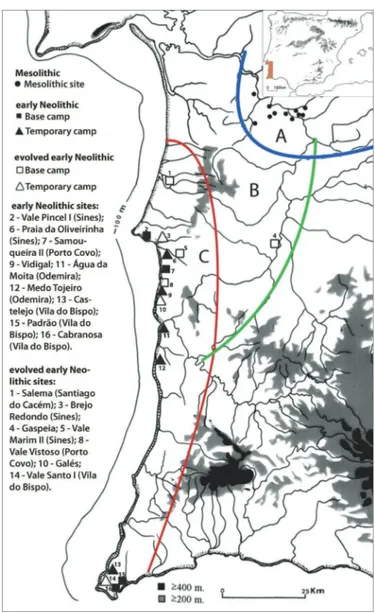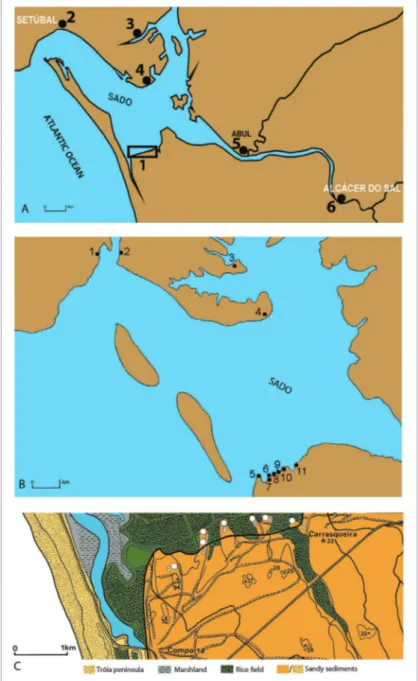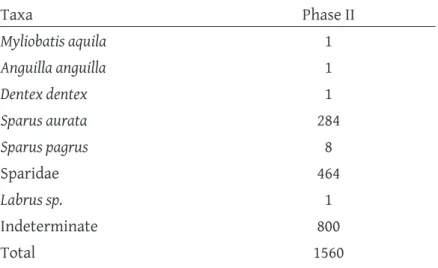— 15 —
Rethinking the Mesolithic of the Sado Palaeo-estuary (Portugal)
Semi-Sedentary Hunter-Gatherers
J
OAQUINAS
OARESKeywords: Mesolithic shell-middens, Neolithization, Portuguese Southwest Coast, Comporta Neolithic The Mesolithic economy of the Sado palaeo-estuary developed parallel to the early stage of food production economy (5700–5300 cal. BC) of the Southwest Portuguese Coast. The Sado Mesolithic communities adopted pottery probably from them, as it was useful for storage but they did not take up their agricultural economy for more than a millennium, maintaining a demographic-ecological balance until 4500/4000 cal. BC. The author presents a synthesis about the Mesolithic of the Sado palaeo-estuary, building a theoretical model of socio-economic dynamics in a long-term perspective.
Introduction
The eleven sites mapped in the innermost palaeo-estuary of the River Sado are distributed from downstream Barrosinha to upstream Xarrama River. These settlements generally have a rela-tively homogeneous locative pattern: on the edge of a plateau overlooking the valley at an aver-age height of 50m, except the site of Barrada das Vieiras that is located at a lower level (Arnaud 1989).Two of these sites (Fonte da Mina and Barranco da Moura) have not been excavated. Funerary areas were identified in six of the nine remaining shell-middens: Arapouco, Vale de Romeiras, Várzea da Mó, Poças de S. Bento, Cabeço do Pez and Amoreiras (Figures 15.1 and 15.2). These Mesolithic settlements are located about 40–50 km upstream from the contemporaneous mouth of the Sado River (Setúbal). The dominant presence of estuarine shells such as cockles (Cerastoderma edule) and peppery furrow-shell (Scrobicularia plana) in the shell midden layers indicates that in Mesolithic times the tide reached this territory.
The most distant sites from the Sado River are Poças de S. Bento located at about 3.5 km distance on the bank of Vale de Açudes stream and Barranco da Moura which is about 13–14 km away. The vegetation mosaic of the plateau carved by Sado and its hydrographic network consisted mainly of mixed forests of pinewoods (mainly Pinus pinea), holm oak (Quercus rotundifolia) and cork oak (Quercus suber) according to the palynological studies developed in the region of Carvalhal and Lagoa Travessa I (Mateus and Queiroz 1997).
Figure 15.1 The three main Late Mesolithic areas identified in Southern Portugal (6500–5700/4500 cal. BC). After Soares 2013.
Most of the excavated sites hosted funerary functions regardless of their different sizes (Figures 15.2, 15.3 and 15.4). The geological survey of Alcacer do Sal done by Francisco Gonçalves and Miguel Telles Antunes (1992, 76) revealed new shell midden scatters at the sites of Cabeço do Pez and Várzea da Mó, suggesting a larger areal extent of these sites (multiple occupation site), still to be tested in future archaeological surveys.
The available information on the Mesolithic settlement strategy of the Sado Palaeo-estuary shows that it has been shaped by strong territoriality (Casimir and Rao 1992), consistent with a broad-spectrum resource exploitation oriented by seasonal schedule of the most important food resources (Barbaza 1999; Grier, Kim and Uchiyama 2006; Rowley-Conwy 1986) and by the awareness of natural regeneration capacity. R. Dean observed that small cockles were collected along the stratigraphic sequence of Amoreiras; therefore the gathering activity maintained its efficiency during the whole occupation (Dean 2010, 66). Cleia Detry (2002–2003, 32) reached a similar conclusion in the zooarchaeologic study of Cabeço do Pez. According to this author, there were no changes in the strategy of exploitation of resources over time “which reveals a large ecosystem stability […] even people were still not in a food production economy.”
The largest collection of fauna analysed so far came from Cabeço do Pez and reveals the diversity of exploited resources. Although studies have focused mainly on mammals, Detry (2002–2003) refers to the presence of osteological remains of birds, namely the genus Alectoris sp., probably the common partridge as well as the presence of numerous fragments of
turtle shells. The dog identified in Cabeço Pez and Poças de S. Bento (information by Mariana Diniz) is the only domestic species in the Sado Mesolithic. Regarding the big game, hunting focused mainly on deer (Cervus elaphus) with 53.7%, followed by wild boar (22.8%); aurochs were also hunted by taking longer trips for more open and distant places, as it is suggested by the selectivity of the parts of prey brought back to the base camp. In Cabeço do Pez, the osteological remains of horse only appear in the lower stratigraphic layer, probably testifying a more nomadic way of life and greater territorial coverage that goes back to the previous Sado settlement system. Lagomorphs are well represented along all the archaeological layers of the site with a slight majority of rabbit over the hare. Carnivores like fox, wildcat, lynx and otter (Lutra lutra) were present in limited quantities as fur resource. The fish remains were very well represented in Arapouco (Arnaud 1989), mainly marine species using estuaries as nursery. The optimal fishing season occurred in spring and summer (March to September). The fishing was also significant in Poças de S. Bento, and was practiced with the use of boats (Larsson 2010) (Figure 15.5).
The Occupational History of Sites
In general, Mesolithic sites of Sado are constituted of three main functional sectors: residen-tial, necropolis and dumps (shell middens). These functional areas were moving (for
superim-Figure 15.3 Amoreiras shell midden. There are two different layers of funerary deposits. The earli-est burial was dated from “6200-6000 cal. BC” (Table 15.1). Old excavations directed by M. Heleno and drawings by Dario de Sousa 1958. After Soares 2013.
Figure 15.4 Poças de S. Bento shell midden. Plan of the lower layer showing the partitioning of activ-ity space between residence and cemetery. There were: several post-holes suggesting a frame for huts; storage and garbage pits; burials (11) in shallow pits with inhumations in a crouched position, and in general without grave goods or with some perforated shells. This archaeological evidence indicates a semi-sedentary lifestyle. Based on Larsson 2010. After Soares 2013.
position and juxtaposition) according to the dynamics of growth, stability, shrinkage, aban-donment and resettling. We have more information on the organization of cemeteries (Figures 15.3 and 15.4) than that of the residential areas, which shows the perishability of domestic structures. In Poças de S. Bento, despite the limited area excavated, a residential sector was identified at the base of the stratigraphic sequence prior to the accumulation of shell depos-its, adjacent to the cemetery excavated by M. Heleno. There were some domestic structures revealing the complexity of Sado Mesolithic groups, namely pits with deposits of shells and red ochre, and also numerous postholes: “the structure was substantial, perhaps serving as a frame for one or more houses” (Larsson 2010, 33). Lars Larsson also noted the presence of fire-cracked stones from remains of hearths, mainly used for culinary purposes (opening bivalves and roasting fish) and burnt clay with impressions of branches. A plan of the lower layer drawn in Cabeço do Pez also revealed remains of hearths, fire-cracked stones and burnt clay with impressions of branches. This area was close to a cemetery where two inhumations in con-tracted position were identified (Soares 2013).
The two largest sites, Cabeço do Pez and Poças de S. Bento contain areas of shell middens covering about 8000 m2 and 4000 m2, high density of artifacts, domestic and funerary struc-tures and they also implemented a broad-spectrum economy (hunting, fishing, gathering and probably storage) (Figure 15.5). They had been occupied until the arrival of the Neolithic inno-vations, when the Mesolithic way of life started to decline and the sites became abandoned (Table 15.1; Figure 15.6). In Cabeço do Pez, especially red deer and wild boar hunting (Detry 2002–2003; Figure 15.5), just as gathering of shellfish and plants (Umbelino et al. 2007; Valagão and Gomes da Silva 2006) were the main economic activities, while in Poças de S. Bento fishing took an important role in the subsistence strategy (Larsson 2010).
In the shell middens of Várzea da Mó and Cabeço do Rebolador shellfish gathering played a very important role. In Cabeço do Rebolador besides the exploitation of cockles and pep-pery furrow-shell they were also gathering oysters and crustaceans (Carcinus maenas). The esti-mated average areas of those shell deposits were about 1000 m2. The narrow range of animal
Figure 15.5 The broad-spectrum economy of the Sado Mesolithic groups. These groups developed a broad-spectrum economy in accordance with the diversity of resources, some amenable to storage, and with the high productivity of the estuarine environment. So, the subsistence strategy could lead to a reduction in mobility. After Soares 2013.
Site Lab Ref. Sample Date 14C (BP) (1σ) (2σ) Arapouco Sac-1560 Human bones (Skeleton 2A) 7200±130 cal BC 6223-5982 (96,3%) cal BC 5942-5928 (3,7%) cal BC 6374-5836 (99,4%) cal BC 5825-5812 (0,6%) Vale de Romeiras
(Middle layers) ICEN -144 Bones 7130±110
cal BC 6202-6194 (1%) cal BC 6152-6150 (1%) cal BC 6100-5879 (97%) cal BC
5851-5851 (1%)
cal BC 6226-5775 (100%)
Amoreiras Beta -125110 Human bones (Skeleton 5) 7230±40
cal BC 6204-6192 (9,2%) cal BC 6182-6172 (7,8%) cal BC 6158-6144 (10%) cal BC 6104-6030 (73%) cal BC 6212-6131 (35,8%) cal BC 6129-6020 (64,2%) Arapouco (Middle
layers) Q-2492 Shells 7420±65 cal BC 6000-5869 (100%) cal BC 6059-5780 (100%) Vale de Romeiras
(Middle layers) ICEN-150 Shells 7390±80 cal BC 5987-5823 (100%) cal BC 6050-5725 (100%) Vale de Romeiras
(Middle layers) ICEN-146 Shells 7350±60 cal BC 5931-5801 (94,5%)cal BC 5946-5936 (5,5%) cal BC 5983-5729 (100%) Poças de S. Bento
(Middle/lower
layers) LU-2769 Shells 7150±70 cal BC 5734-5606 (100%) cal BC 5821-5540 (100%) Cebeço do
Rebolador (Middle
layers) ICEN-277 Shells 7140±70 cal BC 5727-5600 (100%) cal BC 5809-5530 (100%) Poças de S. Bento
(Middle layers) Q-2494 Charcoal 6780±65 cal BC 5722-5635 (100%) cal BC 5801-5608 (95,5%) cal BC 5594-5561 (4,5%) Cebeço do
Rebolador (Middle
layers) ICEN-278 Shells 7100±60 cal BC 5686-5572 (100%) cal BC 5736-5509 (100%) Várzea da Mó
(Middle layers) ICEN-273 Shells 7110±50 cal BC 5692-5597 (100%) cal BC 5729-5535 (100%) Cabeço do Pez Beta-125109 Human bones (Skeleton 4) 6760±40 cal BC 5706-5686 (28%) cal BC 5675-5634 (72%) cal BC 5725-5621 (100%) Poças de S. Bento
(Lower layers) Q-2493 Shells 7040±70 cal BC 5633-5512 (100%) cal BC 5700-5465 (100%) Poças de S. Bento
(Middle/lower
layers) LU-2770 Shells 7050±60 cal BC 5635-5527 (100%) cal BC 5691-5478 (100%) Poças de S. Bento
(Middle layers) Q-2495 Shells 6850±70 cal BC 5477-5348 (100%) cal BC 5548-5287 (100%) Cabeço do Pez
(Middle layers) Q-2497 Shells 6730±75 cal BC 5381-5224 (100%) cal BC 5466-5157 (100%) Cabeço do Pez
(Middle layers) Q-2496 Shells 6430±65 cal BC 5054-4871 (100%) cal BC 5164-4797 (100%) Amoreiras
(Est. B, C.2b) Q-(AM85B2b) Shells 6370±70 cal BC 4979-4800 (100%) cal BC 5073-4708 (100%) Amoreiras
(Est. B, C.2a) Q-(AM85B2a) Charcoal 5990±75 cal BC 4964-4791 (95,2%)cal BC 4981-4970 (4,8%) cal BC 5064-4707 (99%)cal BC 5198-5179 (1%) Cabeço do Pez
(Upper layers) Q-2499 Bones 5535±130 cal BC 4524-4246 (100%)
cal BC 4682-4634 (2,9%) cal BC 4620-4143 (90,5%)
cal BC 4138-4052 (6,6%) Poças de S. Bento
(Upper layers) Ua-425 Human bones (Skeleton 11) 5390±110
cal BC 4340-4222 (52,3%) cal BC 4209-4155 (21,4%) cal BC
4133-4061 (26,3%)
cal BC 4447-4417 (2,7%) cal BC 4402-3982 (97,3%)
Calibrated date* (cal BC)
Phase III Phase II Phase IA
Phase IB
Table 15.1 Sado Mesolithic radiocarbon dates. After Soares 2013.* The program CALIB REV. 6.0 and the calibration curve IntCal09 (Reimer et al. 2009; Stuiver and Reimer 1993) have been used. To calibrate radiocarbon dates on marine shell samples, the marine curve 09.14c was applied, with a ΔR = 0. Sources of uncalibrated radiocarbon dates (BP): Arnaud 1989; Lars-son 1996, 2010; Umbelino et al. 2007.
food resources exploited in these sites gave opportunity for the contribution of plants in the diet of the Mesolithic communities. This was also confirmed by the analysis of palaeo diets (Umbelino et al. 2007).
Arapouco was from the 1st phase of the Mesolithic occupation in Sado (Table 15.1) and had the closest position to the river mouth, with an estimated area of 1174 m2 of shell midden. It had the greatest diversity of shellfish: cockle (Cerastoderma edule); peppery furrow-shell (Scrobiculia plana); purple dye murex (Murex brandaris) and pod razor (Ensis siliqua), and also a good representation of fish remains: meagre (Argyrosomus regius) with some specimens more than 1.5 m in length, gilt-head (Sparus aurata) and some other species of the Sparidae family, in particular snapper (Sparus pagrus), bream (Spondileosoma cantarus), rays (Rajidae family) and a few short fin mako (Isurus axy-rinchus) (Arnaud 2000). In fact, in Arapouco, fishing focused on a wide range of species, dominated by Chondrichthyes (39%); Mugilidae (33%); and Sciaenidae (17%) (Marques-Gabriel 2015).
Figure 15.6 Theoretical framework of the social dynamics of Sado Mesolithic communities. After Soares 2013.
Lithic Industry
The Sado Mesolithic groups developed a characteristic chipped-stone industry, manufactured from local chert in order to produce narrow bladelets (24.4% of all the artifacts of Poças de S. Bento) with an average width between 7.3 mm in Várzea da Mó and 8.0 mm in Poças de S. Bento. These bladelets were mainly used for manufacturing geometric armatures of projec-tiles. The typological group of microlithic geometric armatures of projectiles is dominant in the retouched tools. The design of those microliths seems to have a general trend of evolution from trapezes (lower layers) to segments (upper layers).
In general terms, the Sado Mesolithic sites reveal a great homogeneity regarding raw mate-rials, technology and typology of the lithic industry. Most of the sites had their own intense knapping activity. The retouched tools represent a very small percentage compared to by-products. For example at Poças de S. Bento in a sample of 8444 artifacts the total number of by-products and fragments are 4131 whilst the number of retouched tools is only 435 (5.2%) (Araújo 1995–1997). This lithic assemblage had a slow evolution that can be discernible only in what concerns the group of the geometric microliths. The main common denominator of the Sado lithic techno-complex is the homogeneity of the raw materials: chert and siliceous grey-green schist locally available in the complex volcano-sedimentary basin at Santa Catarina stream, a tributary of the right bank of the Sado River and in the “Sequence of Toca da Moura” from Tournaisian (Geological Map of Portugal, sheet 39-D Torrão). The majority of the artifacts from Cabeço do Rebolador (77.7%), Várzea da Mó (87.9%) and Amoreiras (88.2%) was manufac-tured on these microcrystalline siliceous rocks. The quartz and rock crystal have an average percentage of c. 9.5%.
Unipolar debitage is the dominant technique used to exploit prismatic cores (particularly one-sided cores). G. Marchand (2001) did not observe any sign of the use of the preheating technique. The presence of this method was recorded in a flint core (Araújo 1995–97) from the topmost layer of Poças de S. Bento, that also provided ceramics and a polished stone tool although in the context of Mesolithic economy. The site of Amoreiras (Nukushina 2012), how-ever, revealed significant presence of the preheating raw material technique (about 11% of the artifacts).
Microliths dominate in the group of retouched tools: 54.9% at Várzea da Mó; 34.0% in Cabeço do Rebolador; 67.4% in Poças de S. Bento (Marchand 2001, tab. 17); 52.8% in Amoreiras (Nuku-shina 2012, tab. 14). Only a few other lithic tools were found with marginal retouches and denticulated edges. A small number of scrapers, burins and borers were also discovered. The ratio between geometrics and microburins indicates that microburin technique was used very sparingly in the manufacture of these projectile elements in Várzea da Mó (7.4) and in Poças de S. Bento (7.7). Microburin technique grew in more recent contexts, from Neolithic chronology: 1.4 in Cabeço do Pez (layer with impressed Neolithic pottery) and 3.2 in Amoreiras (also with impressed ceramics).
Grégor Marchand (2001) concluded that Sado lithic industry has a low degree of economic territorial specialization. This suggests that foraging strategies could have been mostly of resi-dential type.On the contrary, the lithic industry of the Mesolithic of the Southwest Coast dis-plays a sharp contrast between two different technological patterns—curated and expediently
organized technology—in accordance to site functionality: base-camps and temporary camps interconnected in a logistical mobility strategy (Soares 1995, 1996; Soares, Tavares da Silva and Canilho 2005–2007).
Ceramics
The use of clay in domestic architecture, more specifically in the isolation of perishable huts, has been documented by burnt clay with impressions of branches in Cabeço do Pez and Poças de S. Bento. The oldest ceramic artifacts—beads—were identified in Poças de S. Bento, dated from the 2nd quarter of the sixth millennium cal. BC (Larsson 2010, fig. 10).
Ceramic vessels appeared in several contexts of Sado Mesolithic around 5200–4500/4000 cal. BC. The most well known pottery came from Cabeço do Pez (Santos, Soares and Tavares da Silva 1974) and Amoreiras (Diniz 2010; Soares 2013). In general, the ceramics from Amoreiras seem to be coarser than the ones from Cabeço do Pez. Both present the same shapes and decorative techniques: impressed, plastic and incised. In the impressed ceramic there is cardial decora-tion (only at Amoreiras). The ceramics of Cabeço do Pez (Figure 15.8) may have been produced locally or regionally. Textures in general are semi-compact with abundant quartz and mica-ceous non-plastic elements (temper): from coarse (0.5–1 mm) to very coarse (> 1 mm). The ceramic production was relatively well controlled in contrast to the early experimental stage (5700–5300 cal. BC) of Vale Pincel I in the Southwest Coast (Soares and Tavares da Silva 2003; Tavares da Silva and Soares 1981). The walls of the ceramic vessels from Cabeço do Pez are less than 9 mm thick in average of about 64% of the total pottery production (Santos, Soares, and Tavares da Silva 1974). Spherical shapes were dominant (53%) followed by hemispherical bowls (20%). Another morphological type has a sub-cylindrical shape with an incomplete profile; flat bottoms are very rare. In general, ceramic vessels are of medium and large sizes (Figure 15.7: 6, 7) that may be intended for cooking purposes and storage.
The decorated ceramic displays a great variety of impressed and incised patterns and also plastic elements. The Cardium impressions were absent at Cabeço do Pez. More often ceram-ics were decorated by a composite motif that seems to represent a wheat spike (Figure 15.7: 1). This type of decoration is very common in the evolved early Neolithic of Estremadura and Alentejo. So, with this decoration, did the Mesolithic population of Cabeço do Pez intend to allude to the wheat fieldsof their neighbouring farmers from the Southwest Coast? Indeed, the pottery appears to be for now the main Neolithic innovation that was adopted by the Meso-lithic communities of Sado, hypothetically through exogamy. The probable integration of Neo-lithic women in MesoNeo-lithic societies, taking the pottery knowledge and the inherent cultural values, can explain the high compatibility of this set of ceramics with the remaining evolved early Neolithic pottery of Central and Southern Portugal dated from 5300/5200 to 4500 cal. BC. The similarity of the pottery of Cabeço do Pez with that of the Neolithic sites of Salema and Vale Marim II located on the Southwest Coast (Figure 15.8) is striking, supporting our proposal of increasing interactions between the two areas (Figure 15.6) (Tavares da Silva and Soares 1981, 2007; Tavares da Silva, Soares and Coelho-Soares 2010).
Territory and Identity
Between c. 6400/6000–4500/4000 cal. BC (Table 15.1) the Mesolithic population was most likely organized in small groups, probably with control of birth and fertility rates (Jackes and Meikle-john 2004) settled on both banks of Sado River between Barrosinha and the Xarrama River (Figures 15.1 and 15.2) in an area that corresponds to the most inner part of the palaeo-estuary.
Figure 15.7 Ceramics from the Mesolithic site of Cabeço do Pez. These ceramics are similar to those of the evolved early Neolithic of the Southwest Coast. The decoration of sherd No. 1 seems to represent wheat spikes with encoded information that could hardly be linked to a Meso-lithic economy. Probably, NeoMeso-lithic women in those complex Sado MesoMeso-lithic groups had introduced the knowledge of pottery. After Soares 2013.
The estuarine environment is one of the most productive ecosystems in our latitudes (Dias and Marques 1999) (Figure 15.5). In this territory of abundance, marine, estuarine, fluvial and terrestrial resources were crossed; it was possible for human groups to survive for a long time without adopting any domestic species. In the Portuguese Southwest Coast, Neolithic tech-nological innovations, agriculture and livestock had been already adopted at 5700–5300 cal. BC (Figures 15.8 and 15.9) (Soares 1995, 1997; Soares and Tavares da Silva 2004). Indeed, in the Sado geographical setting, a successful broad-spectrum economy developed: hunting, fishing and gathering probably complemented by storage (presence of negative domestic structures
Figure 15.8 The Neolithization process. A — Sado Palaeo-estuary, where the Mesolithic groups adopted only the pottery and rare polished stone axes from the “Neolithic package,” in the time span of “5200/5000–4500 cal. BC.” B — area where food production economy was adopted in the evolved early Neolithic, dated between “5300–4500 cal. BC”; C — area of the earliest Neolithic of Portugal dated by radiocarbon from “5700–5300 cal. BC (2 σ).” After Soares 2013.
for storage and ceramics dissociated from food production economy) (Testart 1982). The long history of the Mesolithic settlements and the integration of funerary function in the intra-site space enhance the idea of a semi-sedentary lifestyle. The demographic-ecologic balance of these groups seems to be controlled, allowing a strong sense of territoriality.
Figure 15.9 Rhythms of neolithization (an interpretive framework). A — Southwest Coast. Late Mes-olithic groups by hypothesis through cultural osmosis adopt (“5700–5300 cal. BC”) the technological Neolithic innovations and a mixed economy where foraging practices were probably predominant besides the presence of farming. B — Inner-Sado basin. The Meso-lithic groups reached food production economy later on in the evolved early NeoMeso-lithic. C — Sado Palaeo-estuary. The Late Mesolithic territory collapsed in about “4500–4000 cal. BC” and the inhabitants of this region moved downstream to settle in the banks of the “new” estuary (D) relying on the traditional wild resources (fishing-gathering acitivities) complemented by some agriculture and livestock.
Later on, Mesolithic communities choose to adopt pottery and some very rare polished stone tools from the available set of Neolithic innovations (c. 5200–4500 cal. BC). Ceramic vessels were probably very useful for storage in semi-sedentary societies (Amoreiras, Cabeço do Pez, Poças de S. Bento). The preceding statement is confirmed by radiocarbon dates obtained at Amorei-ras (Table 15.1) from a Mesolithic context with impressed, plastic and incised ceramics, as well as from the middle and upper layers of Cabeço do Pez, also with the same type of pottery (Figure 15.8). The ceramic decorative patterns are characteristics of the evolved early Neolithic, extended over the current Portuguese territory. At the top layer of Cabeço do Pez a pair of mill-stones was discovered besides impressed ceramics. A polished stone axe was obtained in the superficial layer of Poças de S. Bento (Araújo 1995–97, 105). These archaeological contexts, only with wild fauna, exception for the dog, correspond to the third phase (collapse) of the Mesolithic settlement system of the Sado palaeo-estuary at 4500–4000 cal. BC (Table 15.1 and Figure 15.6).
The diet of the Mesolithic communities of the lower Sado valley (Arapouco, Amoreiras, Cabeço do Pez, Poças de S. Bento and Vale de Romeiras) was studied through the analysis of trace oligo-elements and stable isotopes of carbon (δ13C) and nitrogen (δ15N) (Umbelino et al. 2007). These studies showed the existence of a mixed diet that integrated resources from marine and terrestrial origins (wild animals and especially plants). The great variety and abundance of vegetable resources (for example roots, tubers, fungi, berries, wild herbs and hard-shelled fruits such as pinions and holm oak acorns) were certainly an important part of their food. Meat consumption of terrestrial origin had medium values dominantly from red deer (Cervus elaphus). Marine resources supplied approximately 30% of the Sado Mesolithic diet (Umbelino et al. 2007) which differed in accordance to the banks of the river: habitats on the left bank of the palaeo-estuary (Arapouco, Amoreiras and Poças de S. Bento) showed a higher consump-tion of marine resources, while those of the right bank (Cabeço do Pez and Vale de Romeiras) revealed a lower intake of marine foods. It should be noted that the information provided by the chemical analysis of the bones refers to the last 7–10 years of individual lives. These data are not consistent with the model proposed by J. Arnaud (1989): “a single community, which occupies seasonally different shell middens” because if so, than the concentration of the oligo-elements present in the bones would not have statistically significant differences (Umbelino et al. 2007, 70). Therefore the information regarding palaeodiets points out the existence of two sub-groups in the Sado Mesolithic population, whose settlement structure was clearly aligned with the palaeo-estuary. Hypothetically, next to the two large base-camps (Poças de S. Bento, on the left bank, and Cabeço do Pez, on the right bank) several smaller settlements could gen-erate in each sub-group by the fission of those former sites. They were probably occupied throughout the year as suggested by intense dynamism and funerary function (Figures 15.2, 15.3 and 15.4). In fact, the archaeological record of most of these sites shows that the settle-ments begun with a cemetery. This was a way of permanent appropriation of the territory. Temporary and economically specialized sites of gathering and/or hunting completed prob-ably the settlement structure of each sub-group. Because of their short duration, it is difficult to point them out in the archaeological record. The site of Barrada do Grilo (Santos, Soares, and Tavares da Silva 1972) fits the profile function described, without any necropolis, with a gathering economy based on mollusc fauna and low density of artifacts.
The bioanthropologic study of the Mesolithic population of Sado (Cunha and Umbelino 1995– 97) revealed that adults and non-adults of both sexes were inhumated in the burial areas inte-grated in the residential space (Amoreiras, Vale de Romeiras and Poças de S. Bento) (Figures 15.2, 15.3 and 15.4) with a clear emphasis on the adults. This feature indicates sociocultural constraints related by age in the access of the necropolis because supposedly infant mortality would be high. A significant percentage (23%) of the deceased from the necropolis of Arapouco died over the age of 40. The social importance of elderly is a good indicator of a semi-sedentary population (with some economic surplus). In general, the burials were in single pits and the deceased were deposited in either lateral or dorsal contracted position. An exceptional joint burial of woman and child was observed in Sado. The burials were excavated in the sandy geo-logical substrate and in one case (Romeiras) they seem to have been oriented radially facing a central focus (Soares 2013, fig. 13).
The grave goods have not been properly individualized, but some inhumations were accom-panied by projectiles (geometric microliths) and beads made of gastropod shells (Arnaud 2000, 33). This statement is consistent with the malacofaunistic study of the site of Amoreiras (Dean, 2010, 66): “All but 6 of the 55 specimens of Theodoxus sp. were perforated for use as beads. Three of the six shells belonging to the genus Hinia sp. were used as beads. Additionally, all four of the Trivia monacha were beads.”
The average height of adult males in Sado was estimated at 1.61 m. In this community a severe tooth wear was observed (Arapouco); some usage that was not correlated with chewing was detected on the anterior dentition, which could be the result of other activities such as preparing skins. Mesolithic Sado population had lesions of “traumatic etiology in individuals of both sexes” (Cunha and Umbelino 1995–1997). These lesions of osteoarthritis testify great physical activity, particularly in the form of frequent trips with heavy loads, probably due to resource depletion close to the home camp.
The lithic industry (geometric microlithic facies) studied so far at Cabeço do Pez, Poças de S. Bento, Cabeço Rebolador, Varzea da Mó and Amoreiras points towards a long sedimentation of a technological tradition whose main operational chain aimed at the production of microblades and geometric armatures of projectiles. The tools were manufactured from medium quality siliceous materials locally available either in outcrops or in secondary sources re-mobilized by fluvial action. The territorial self-sufficiency respect to raw mineral materials contributed to consolidate the identity of the Sado Mesolithic groups (Fernandez Götz and Ruiz Zapatero 2011). Conclusion: From the Collapse of the Mesolithic Territory to the Comporta Neolithic
Settlement System
In synthesis (Table 15.1; Figure 15.6): the occupation of Sado palaeoestaury was probably initi-ated by two small groups that established on both banks of the river. They left their signature in the necropolis of Arapouco and Amoreiras on the left and Vale de Romeiras on the right bank at 6400–5800 cal. BC (Table 15.1). They developed a hunting-fishing-gathering-storage economy, which characterizes the Mesolithic groups from the two main Portuguese estuar-ies: Sado and Tagus. In such favourable environmental conditions the Mesolithic communi-ties could compete with the food production economy of the Southwest Coast. The settlement was consolidated in these territories particularly rich in food resources, with great amounts
Figure 15.10 Geographical setting of the Middle and Late Neolithic sites of the lower Sado Valley,
c. 4000/3900–2900/2700 cal. BC. Its territory is located downstream from the Mesolithic
territory and close to the contemporaneous mouth of the river: A — View of the contem-poraneous estuary whith the Neolithic sites of: 1) Comporta territory; 2) Urban area of Setúbal; 3) Faralhão: 4) Mitrena; 5) Abul; 6) Hill of Alcácer do Sal Castle. After Soares and Tavares da Silva 2013. B — Palaeogeographical reconstruction of the Sado River mouth (“4th millennium cal. BC”): 1–2) urban area of Setúbal; 3) Faralhão, 4) Mitrena; 5–11) Com-porta habitats. After Soares 2008. C — Contemporaneous geography of ComCom-porta with the Neolithic sites: 1) Celeiro Velho; 2) Possanco; 3) Malhada Alta; 4) Pontal; 5) Barrosinha; 6) Sapalinho; 7) Carrasqueira. After Soares and Tavares da Silva 2013.
of estuarine-marine molluscs, which gave significant safety from starvation because of their abundance and availability throughout the year (Tavares da Silva and Soares 1997). The Sado Mesolithic population reached the peak of its development during the phases IA and IB (c. 6400–5300 cal. BC). At this period a phenomenon of aggregation was registered with at least two large habitats (Poças de S. Bento and Cabeço do Pez), which could have originated by fission of several small and medium settlements scattered over the territory with relative autonomy, occupied throughout the year. There might have been some economically special-ized short-term camps that were difficult for the archaeological survey to recognize, as may have been in the case with Barrada do Grilo.
The Neolithic innovations were probably known but not yet adopted by Sado Mesolithic groups until c. 5200–5000 cal. BC. Hypothetically, at this time (phase II; Table 15.1; Figure 15.6) Mesolithic communities of Sado reinforced contacts with the peasants of the Southwest Coast and this led them to absorb the innovation of pottery (Tavares da Silva and Soares 2007), a good indicator of the ongoing process of semi-sedentarization, storage and the correlative
Table 15.2 Vertebrate fauna at Barrosinha, phase II (Middle Neolithic of Comporta). Analysis by An Lentacker 1990–91. After Soares and Tavares da Silva 2013.
Table 15.3 Remains of fish species at Barrosinha, phase II (Middle Neolithic of Comporta). Analysis by An Lentacker, 1990–91. After Soares and Tavares da Silva 2013.
Vertebrate fauna Phase II
Fish 1560 (61.9 %) Birds 646 (25.6 %) Wild mammals 63 (2.5 %) Domestic mammals 17 (0.7 %) Indeterminate mammals 235 (9.3 %) Total 2521 (100 %) Taxa Phase II Myliobatis aquila 1 Anguilla anguilla 1 Dentex dentex 1 Sparus aurata 284 Sparus pagrus 8 Sparidae 464 Labrus sp. 1 Indeterminate 800 Total 1560
increase in sociability levels. In Amoreiras, Cabeço do Pez, Poças de S. Bento and Várzea da Mó impressed and incised ceramics and very rare polished stone tools were integrated in the Mesolithic contexts exclusively with wild fauna remains. The radiocarbon dates obtained from the skull of the grave XI of Poças de S. Bento and from the top layer of Cabeço do Pez signal-ize the collapse of the Sado Mesolithic settlement system and socioterritorial identity around “4500–4000 cal. BC” (phase III; Table 15.1; Figure 15.6).
Following the migration of estuarine conditions (Freitas and Andrade 2008) to the contem-poraneous mouth of the Sado River (Setúbal-Comporta) the prehistoric settlement system changed (Figures 15.9, 15.6 and 15.10), and a particular agro-maritime economy (Tables 15.2, 15.3) centered in fishing, shellfish gathering and salt exploitation developed around Comporta, in the Middle and Late Neolithic, during the 4th millennium cal. BC (Soares and Tavares da Silva 2013; Tavares da Silva et al. 1986). Although much more fieldwork will be necessary, in our theoretical model, the Neolithic groups of Comporta are probably the last descendants of Sado Mesolithic communities.
The well-preserved and large faunal assemblage of the second phase of the site of Barrosinha (Comporta) illustrates quite well the agro-maritime economy of the Neolithic of Comporta (Tables 15.2, 15.3), and its dependence on fishing activity. The referred context had been dated by radiocarbon in the time span of 3600–3184 cal. BC (2 σ) (Beta-221720; CSIC-649).
In the latest phase of the Neolithic of Comporta (Possanco), in the transition to the “3rd millennium cal. BC” (3300–2800 cal. BC) (Soares and Tavares da Silva 2013; Table 15.1), the salt exploitation reached a very high development to supply the large settlements of the interior (ditched enclosures) that have benefited a substantial growth of the volume of production pro-voked by the Secondary Products Revolution (SPR). Just after this peak, the available empirical record expresses a sudden abandonment of the Neolithic territory of Comporta.
Acknowledgements
I would like to thank Barbara Polyak for the English translation. I am also grateful to Carlos Tavares da Silva for the debate held on the issue presented in this paper, and to Ana Castela for preparing the final digital illustrations.
References
Araújo, Ana Cristina. 1995–97. “A indústria lítica de Poças de S. Bento (vale do Sado) no seu contexto regional.”
O Arqueólogo Português 13–15 (S. 4): 87–159.
Arnaud, José Morais. 1989. “The Mesolithic communities of the Sado valley (Portugal) in their ecological setting.” In The Mesolithic in Europe—Papers Presented at the III International Symposium/Edinburgh 1985, edited by C. Bonsall, 614–631. Edinburgh: John Donald Publishers.
Arnaud, José Morais. 2000. “Os concheiros mesolíticos do vale do Sado e a exploração dos recursos estuarinos (nos tempos pré-históricos e na actualidade).” In Actas do Encontro sobre a Arqueologia da Arrábida, 21–43. Lisboa: IPA. Barbaza, Michel. 1999. Les civilisations postglaciaires. La vie dans la grande forêt tempérée. Paris: La Maison des Roches. Casimir, Michael J. and Aparna Rao, eds. 1992. Mobility and territoriality. Social and spatial boundaries among foragers,
fishers, pastoralists and peripatetics. New York: Berg.
Cunha, Eugénea, and Cláudia Umbelino. 1995–1997. “Abordagem antropológica das comunidades mesolíticas dos concheiros do Sado.” O Arqueólogo Português 4(13/15): 161–179.
Dean, Ruth. 2010. “Mesolithic shellfish remains from Amoreiras, São Romão, Portugal.” In Os últimos
caçadores-recolectores e as primeiras comunidades produtoras do sul da Península Ibérica e do norte de Marrocos (Promontoria
Detry, Cleia. 2002–2003. Estudo Arqueozoológico de um concheiro mesolítico do Sado – Cabeço do Pez – Alcácer do Sal, Portugal. (Trabalho de introdução à investigação histórico-arqueológica). Universidade de Salamanca.
Dias, António Antunes, and José M. Silva Marques. 1999. Estuários. Estuário do Tejo e o seu valor e um pouco da sua história. Alcochete: Reserva Natural do Estuário do Tejo.
Diniz, Mariana. 2010. “O concheiro mesolítico do Cabeço das Amoreiras (S. Romão do Sado, Alcácer do Sal): um (outro) paradigma perdido?” In Os últimos caçadores-recolectores e as primeiras comunidades produtoras do sul da
Península Ibérica e do norte de Marrocos (Promontoria Monográfica 15), edited by J. F. Gibaja and A. F. Carvalho,
49–61. Faro: Universidade do Algarve.
Fernández Götz, Manuel A., and Gonzalo Ruiz Zapatero. 2011. “Hacia una arqueología de la etnicidad.” Trabajos de
Prehistoria 68(2): 219–236.
Freitas, Conceição, and César Andrade. 2008. “O estuário do Sado.” In Embarcações Tradicionais. Contexto físico-cultural
do estuário do Sado, edited by Joaquina Soares, 20–29. Setúbal: Museu de Arqueologia e Etnografia do Distrito de
Setúbal (MAEDS).
Gonçalves, Francisco, and Miguel Telles Antunes. 1992. Noticia explicativa da folha 39-D Torrão. Lisboa: Serviços Geológicos de Portugal.
Grier, Colin, Jangsuk Kim, and Junzo Uchiyama, eds. 2006. Beyond affluent foragers. Rethinking hunter-gatherer
complex-ity. Oxford: Oxbow Books.
Jackes, Mary and Cristopher Meiklejohn, 2004. “Building a method for the study of the Mesolithic-Neolithic transi-tion in Portugal.” In The Neolithizatransi-tion of Eurasia—paradigms, models and concepts involved. Neolithic Studies, 1 (Docu-menta Praehistorica, 31), 89–111. Ljubljana: Oddelek za arheologijo Filozofske fakultete Univerze v Ljubljani; Narodna in univerzitetna knjižnica.
Larsson, Lars. 1996. “Late Atlantic settlement in southern Portugal: Results of an excavation of a Mesolithic shell midden by the River Sado.” Current Swedish Archaeology 4: 123–139.
Larsson, Lars. 2010. “Poças de S. Bento—a Mesolithic shell midden by the River Sado, Southern Portugal.” In On Pre
and Earlier History of Iberia and Central Europe. Studien Zur Archäologie Europas 11, edited by Tanya Armbruester
and Morten Hegewisch, 29–43. Bonn: Verlag Dr. Rudolf Habelt GmbH.·
Lentacker, An. 1990–1991. Archaeozoölogisch onderzuek von Laat -prehistorische vindplaatsen uit Portugal. Laboratorium voor Paleontologie; Faculteit Wetenschappen. Gent: Rijksuniversiteit. Unpublished doctoral thesis.
Marchand, Grégor. 2001. “Les traditions techniques du Mésolithique final dans le sud du Portugal: les industries lith-iques des amas coquilliers de Várzea da Mó et de Cabeço do Rebolador (fouilles M. Heleno).” Revista Portuguesa
de Arqueologia 4(2): 47–110.
Marques-Gabriel, Sónia. 2015. “La ictiofauna del Holoceno inicial y medio de Potugal.” Unpublished Phd thesis, Facultad de Ciências, Universidad Autónoma de Madrid.
Mateus, José Eduardo, and Fernanda P. Queiroz. 1997. “Aspectos do desenvolvimento, da história e da evolução da vegetação do litoral norte alentejano durante o Holocénico.” Setúbal Arqueológica 11/12: 49–68.
Nukushina, Diana. 2012. Tecno-tipologia lítica e cronometria no Mesolítico final do vale do Sado. O caso do concheiro das
Amoreiras (Alcácer do Sal). Unpublished Phd thesis, Faculdade de Letras da Universidade de Lisboa.
Reimer, P. J., M. G. L. Baillie, E. Bard, A. Bayliss, J. W. Beck, P. G. Blackwell, C. Bronk Ramsey, C. E. Buck, G. S. Burr, R. L. Edwards, M. Friedrich, P. M. Grootes, T. P. Guilderson, I. Hajdas, T. J. Heaton, A. G. Hogg, K. A. Hughen, K. F. Kaiser, B. Kromer, G. Mccormac, S. Manning, R. W. Reimer, D. A. Richards, J. R. Southon, S. Tálamo, C. S. M. Turney, J. Van Der Plicht and C. E. Weyhenmeyer. 2009. “IntCal09 terrestrial radiocarbon age calibration, 0–26 cal Kyr BP.” Radiocarbon 51: 1111–1150.
Rowley-Conwy, Peter. 1986. “Sedentary hunters: The Ertebølle example.” In Hunters in Transition, edited by M. Zvel-ebil, 67–93. Cambridge: Cambridge University Press.
Santos, Manuel Farinha dos; Joaquina Soares, and Carlos Tavares da Silva. 1972. “Campaniforme da Barrada do Grilo (Torrão – vale do Sado).” O Arqueólogo Português 6 (S. 3): 163–192.
Santos, Manuel Farinha dos; Joaquina Soares, and Carlos Tavares da Silva. 1974. “O concheiro epipaleolítico do Cabeço do Pez (vale do Sado – Torrão). Primeira notícia.” In Actas do III Congresso Nacional de Arqueologia (Porto
1973) 1: 173–190. Porto.
Soares, Joaquina. 1995. Mesolítico-Neolítico na Costa Sudoeste: transformações e permanências. In Actas do 1º
Soares, Joaquina. 1996. “Padrões de povoamento e subsistência no Mesolítico da Costa Sudoeste portuguesa.”
Zephy-rus 49: 109–124.
Soares, Joaquina. 1997. “A transição para as formações sociais neolíticas na Costa Sudoeste portuguesa.” In Neolítico Atlántico e as Orixes do Megalitismo, edited by A. Rodríguez Casal, 587–608. Santiago de Compostela: Conselho de Cultura Galega, Universidade de Santiago de Compostela, União Internacional das Ciências Pré e Proto-históricas.
Soares, Joaquina (coord.). 2008. Embarcações tradicionais do Sado. Contexto físico-cultural do estuário do Sado. Setúbal: MAEDS /APSS.
Soares, Joaquina. 2013. “Caçadores-recolectores semi-sedentários do Mesolítico do paleoestuário do Sado (Portu-gal).” In Pré-história das Zonas Húmidas. Paisagens de sal (Setúbal Arqueológica 14), edited by Joaquina Soares, 13–56. Setúbal: MAEDS.
Soares, Joaquina and Carlos Tavares da Silva. 2003. “A transição para o Neolítico na Costa Sudoeste portuguesa.” In Muita gente, poucas antas? Origens, espaços e contextos do Megalitismo. Actas do II Colóquio Internacional sobre
Megalitismo, edited by Victor S. Gonçalves, 45–56. Lisboa: IPA.
Soares, Joaquina, and Carlos Tavares da Silva. 2004. “Alterações ambientais e povoamento na transição Mesolítico-Neolítico na Costa Sudoeste.” In Evolução Geohistórica do Litoral Português e Fenómenos Correlativos, edited by António A. Tavares, Maria José F. Tavares, and João L. Cardoso, 397–423. Lisboa: Universidade Aberta.
Soares, Joaquina and Carlos Tavares da Silva. 2013. “Economia agro-marítima na Pré-história do estuário do Sado. Novos dados sobre o Neolítico da Comporta.” In Pré-história das Zonas Húmidas. Paisagens de sal (Setúbal Arque-ológica 14), edited by Joaquina Soares, 13–56. Setúbal: MAEDS.
Soares, Joaquina, Carlos Tavares da Silva and Maria Helena Canilho. 2005/2007. “Matérias-primas minerais e mobi-lidade logística no Mesolítico da Costa Sudoeste. Os sítios de Samouqueira I e Armação Nova.” Musa: museus,
arqueologia e outros patrimónios 2: 47–62.
Stuiver, Minze, and Paula J. Reimer, 1993. “Extended 14C data base and revised CALIB 3.0 14C age calibration.”
Radio-carbon 35: 215–230.
Tavares da Silva, Carlos, and Joaquina Soares. 1981. Pré-história da Área de Sines. Lisboa: Gabinete da Área de Sines. Tavares da Silva, Carlos, and Joaquina Soares. 1997. “Economias costeiras na Pré-história do Sudoeste Português.
O concheiro de Montes de Baixo.” Setúbal Arqueológica 11/12: 69–108.
Tavares da Silva, Carlos, and Joaquina Soares. 2007. “Osmose cultural e neolitização na Pré-história europeia. A propósito da transição mesolítico-neolítico no Sul de Portugal.” Estudos Arqueológicos de Oeiras 15: 37–46. Tavares da Silva, Carlos, Joaquina Soares, and Antónia Coelho-Soares. 2010. “Arqueologia de Chãos de Sines. Novos
elementos sobre o povoamento pré-histórico.” In Actas do 2º Encontro de História do Alentejo Litoral, 11–34. Sines: Centro Cultural Emmérico Nunes.
Tavares da Silva, C., Joaquina Soares, João L Cardoso, Carlos Souto Cruz, and Carlos A. S. Reis 1986. “Neolítico da Comporta: aspectos cronológicos (datas 14C) e paleoambientais.” Arqueologia 14: 59–82.
Testart, Alain. 1982. Les chasseurs-cueilleurs ou l`origine des inégalités. Paris: Société d’Etnographie.
Umbelino, Cláudia, Alejandro Pérez-Pérez, Eugénea Cunha, Carla Hipólito, Maria do Carmo Freitas, and João Peixoto Cabral. 2007. “Outros sabores do Passado: um novo olhar sobre as comunidades humanas mesolíticas de Muge e do Sado através de análises químicas dos ossos.” Promontoria 5(5): 45–90.
Valagão, Maria Manuel, and Joana Gomes da Silva. 2006. “As tradições alimentares.” In Tradição e inovação alimentar.
